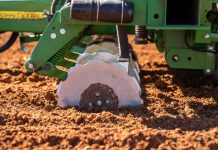
It truly is an exciting time in agriculture with the advent of new technologies aimed at ensuring that all necessary resources are optimised for producers in the ultimate goal of sustainable food production.
Technologies such as drones can help producers collect vital information about their crops, helping them understand which crop protection products and nutrients they need, in what amount, and where and when to use them. They also show promise as a way of applying crop protection products for those that are registered for use by aerial application. Because of targeted application, drones can deliver the active ingredient exactly to where it is needed on the plant and it also uses up to 90% less water, which is an important benefit for a water-scarce country such as South Africa.
As tempting as it may be to just jump in and start using these available tools, producers and operators must remember to comply with the regulations that govern these technologies. Requirements for the use of drones for the aerial application of pesticides are embedded in Act No. 36 of 1947 and Act No.13 of 2009.
In short, any person doing aerial application of pesticides for financial gain must be:
- Registered as a pest control operator for aerial application under Act No. 36 of 1947;
- compliant with all the requirements of Act No. 13 of 2009;
- licensed to operate a drone (remotely controlled aircraft) under Act No. 13 of 2009;
- registered under Act 13 of 2009;
- a certified remotely piloted aircraft operator under Act No. 13 of 2009;
- in possession of a certificate of competency to operate a radio communications system; and
- in possession of a system for radio communications.
These requirements are not different to those applicable to commercial pilots operating fixed-wing aircraft or helicopters for aerial application of pesticides. However, these are specific to persons operating drones for aerial application of pesticides.
Although the above provides a good summary, it is advisable for operators and producers to familiarise themselves with the details below as well to ensure compliance.
Defining pesticides
Agricultural remedies or pesticides are defined in Section 1 of the Fertilisers, Farm Feeds, Agricultural Remedies and Stock Remedies Act, 1947 (Act No. 36 of 1947) as including insecticides, herbicides, fungicides, avicides, rodenticides, miticides, nematicides, algaecides, plant growth regulants, adjuvants and other related products of chemical or biological origin. Such pesticides may only be applied for purposes and in manners as directed by label instructions according to Regulation No. R1716 of 26 July 1992 of Act No. 36 of 1947.
Requirements for aerial application
If aerial application of pesticides is executed by a pilot that does it in the course of business, the pilot must comply with Section 7 (2) (a) (ii) of the Act (quoted verbatim from the Act): ‘No person shall for reward or in the course of any industry, trade or business use any agricultural remedy unless he is a pest control operator registered in terms of this Act or otherwise than in the presence and under the supervision of a pest control operator so registered.’
This means that a pilot offering aerial application of pesticides by aircraft for commercial gain must conform to the following requirements:
- Be registered (licensed) as a pest control operator under Act No. 36 of 1947, meaning the pilot shall have a registration certificate with a P-number issued by the Registrar of Act No. 36 of 1947.
- The pilot shall first comply with all the conditions of the South African Civil Aviation Authority.
Requirements for aerial application of pesticides by drone
The requirements of the Civil Aviation Act, 2009 (Act No. 13 of 2009), the Civil Aviation Regulations of 2011 and the 8th amendment to the regulations of 2015 in summary, are as follows for a pilot operating a remotely piloted aircraft (drone):
- Be licensed to pilot remotely licensed aircraft for multirotor devices (drones).
- Be certified as proficient in the use of aeronautical radiotelephony.
- Have in his possession a functional air band radio.
- Be in possession of a valid remotely piloted aircraft system (RPAS) operator’s certificate (ROC).
- Have certificates of registration for each remotely piloted aircraft (RPA) in his possession (RLA).
- Have a copy of the letter of approval (RLA).
- Be licensed as a pest control operator (aerial application) in terms of Act No. 36 of 1947, which is subject to the pilot first meeting all the requirements of the Civil Aviation Authority.
CropLife SA urges any drone operator who wishes to offer services as an aerial applicator to undergo the necessary training, certification and licensing in terms of both acts before commencing aerial application of agricultural remedies.




























